The basic concept of the Dyson Sphere1 is straightforward: rather than squander stellar output by permitting it to radiate into space, one can surround the star with a shell to intercept light, thus permitting the energy to be put to use. From the viewpoint of the star system’s inhabitants, this would be a useful source of energy (although any civilization able to turn its planets into a Dyson Sphere would be at most twenty years from commercial controlled fusion). From our Earth perspective (as was Dyson’s), the Dyson Sphere’s infrared emissions, visible across the lightyears, would be evidence of an alien civilization of tremendous achievement.2
There are at least two kinds of Dyson Sphere. The first—the one Dyson intended—is made up of a myriad of independently orbiting objects. While this presents an interesting traffic control challenge, the Dyson Swarm has the advantage that not only can it be built incrementally over a very long period, but the components are gravitationally coupled to the star in question.
The second option is a solid shell with the star in the middle. Shells present all manner of problems, many related to the fact that a shell would not be coupled to the star in the middle. Absent some station-keeping mechanism, the position of the star could drift with respect to the shell over time. This would be bad. As well, the net attraction between the inner surface of the shell and any object on the inner shell would be zero, while the net attraction between said object and the star would be non-zero, allowing the object to plummet into the star. This would also be bad.
Alas, while Dyson’s letters made it clear his mental image was of a swarm, his consistent use of the word “shell” established the second variety of Dyson Sphere as the default variety, and the variety adopted by most SF authors. Here are five SF novels featuring Dyson shells.
Orbitsville by Bob Shaw (1975)
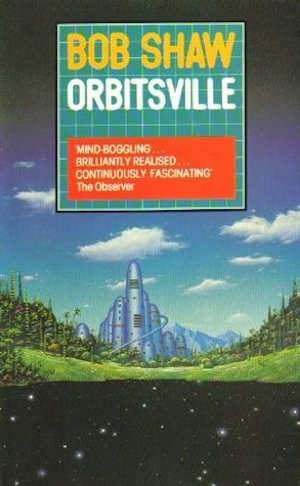
While a competent starship pilot, Vance Garamond is an incompetent babysitter. Tasked with watching his boss’s child, he lets Elizabeth Lindstrom’s child wander away, and the boy falls to his death. Elizabeth Lindstrom is powerful and vindictive; she is certain to take revenge on her negligent employee. So Garamond commandeers a starship and flees the Earth with his family. But where can they go? His boss’s company controls interstellar flight. If he and his family take refuge on any human-settled world, the boss will know. Solution: eschew known worlds for unexplored territory, using star-maps from an extinct alien civilization as his guide.
In the middle of what seems like empty space, Garamond stumbles over “Orbitsville,” a Dyson Shell with a billion times the surface area of Earth. He decides that it’s safe to tell the Earth about his find. Fame will surely protect Garamond from Lindstrom’s wrath!
This is a potentially fatal misjudgment. Being the Earth’s most famous explorer does not mean Garamond and his family cannot be murdered. It simply means murder will have to be disguised as accident. Not hard for the woman who controls spaceflight.
Search for the Sun by Colin Kapp (1982)
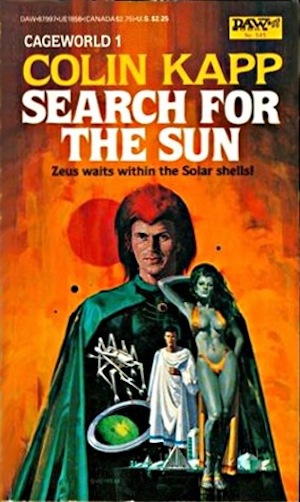
Civilized ingenuity has transformed the Solar System into Solaria, a system of concentric shells centred on the Sun. At least, this is what the history texts assure the inhabitants of Aster Space, the region between the Mars-orbit and asteroid-orbit shells. Both outer and inner limits of Solaria are purely conjectural. Dissatisfied with this state of affairs, visionary Land-a, Prince of Hammanite, dispatches an expedition to the innermost shell of Solaria, there to seek out Zeus, the A.I. that rules Solaria.
Zeus may be a machine but it is very nearly a god. Like many gods, it has very little interest in the concerns of individual mortals. Also, as gods are wont to do, Zeus has many ways of discouraging mortal hubris…as the explorers will soon discover.
Federation World by James White (1988)
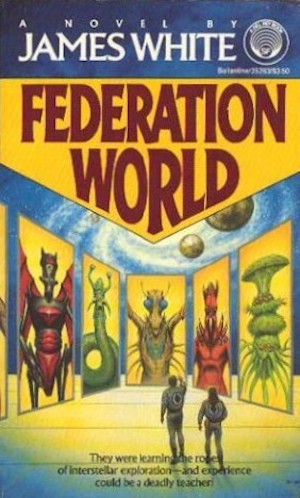
Federation World is perhaps the Federation of Galactic Sentients’ greatest social program. An entire stellar system has been reshaped into a single structure with over a billion times the surface area of the Earth, designed to provide every intelligent species in the galaxy—known and unknown—with sufficient room to live in unparalleled luxury.
Of course, before this largess can be made available, someone has to find and establish diplomatic relations with every civilization in the galaxy. This is where humans Martin and Beth come in. Unsuited to life on Federation World, they will instead seek out unknown beings more suited to the grand experiment.
Noumenon by Marina J. Lostetter (2017)
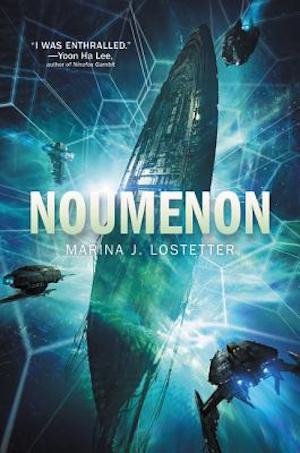
In 2088, Reggie Straifer discovers an enigmatic stellar object, almost certainly artificial and quite possibly a Dyson Sphere. Providentially, Straifer has made his discovery at a time when humanity has both the means and the will to travel to that distant object. There is just the smallest catch: the structure—if it is a structure—is so distant that a round trip will take two thousand years by Earth’s clocks. Even from the explorers’ perspective, over two centuries will pass. Maintaining mission focus will be challenging.
Conveniently, the Planet United Consortium has the means to ensure that the expedition will avoid the known pitfalls of generation ships (as established in so very many science fiction novels). Said means are inhumane but you know what they say about eggs and omelets…
“Back to Myan” by Regina Kanyu Wang (2017)3
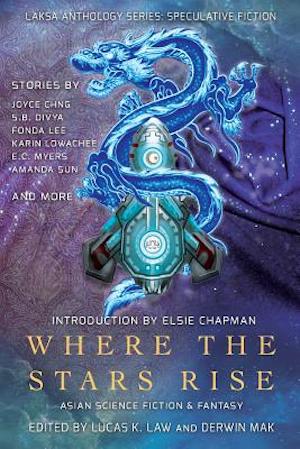
Retrieved by the Union from certain extinction on the ice-encrusted world Myan, Kaya is somewhat less than entirely grateful. After all, the reason Myan was freezing in the first place was Project Saion, the Union’s vast energy-gathering structure blocking Myan from its star, Saion. While the Union did belatedly notice the Myan natives and rescue them, this didn’t come to pass until 997 out of every 1000 of Kaya’s species had perished in the cold. Still, the Union is very, very powerful, while the handful of Myans are not. There is nothing Kaya can do to save her home world. At least, that’s what the Union believes…
***
I have infinite faith in your ability to spot the obvious examples4 I should have included in this essay, were I more on the ball. Comments are below.
In the words of Wikipedia editor TexasAndroid, prolific book reviewer and perennial Darwin Award nominee James Davis Nicoll is of “questionable notability.” His work has appeared in Publishers Weekly and Romantic Times as well as on his own websites, James Nicoll Reviews and Young People Read Old SFF(where he is assisted by editor Karen Lofstrom and web person Adrienne L. Travis). He is a four-time finalist for the Best Fan Writer Hugo Award and is surprisingly flammable.
[1]Although Dyson credits Olaf Stapledon for the basic concept, Freeman Dyson’s lyrical “Search for Artificial Stellar Sources of Infrared Radiation” (http://www.islandone.org/LEOBiblio/SETI1.HTM) codified the concept vividly enough that we call the eponymous megastructures Dyson Spheres and not Stapledonian Spheres.
[2]Since the applications of a Dyson Sphere include the Nicoll-Dyson Laser (https://en.wikipedia.org/wiki/James_Nicoll#Nicoll-Dyson_Laser), which can be used to evaporate Earth-sized worlds at a distance of a million light-years (see https://en.wikipedia.org/wiki/The_Rapture_of_the_Nerds), I am happy to report that thus far none have been detected.
[3]This is a short story included in Derwin Mak and Lucas K Law’s anthology “Where the Stars Rise: Asian Science Fiction and Fantasy.”
[4]The Dyson Sphere referenced in Doctorow and Stross’ Rapture of the Nerds is a swarm, not a shell. One is equipped with a Nicoll-Dyson Laser, one of very few examples of NDLs in SF fiction










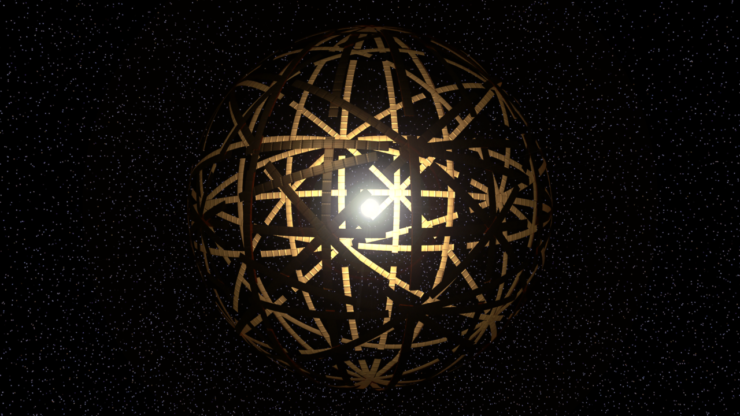
The only Dyson sphere I’ve encountered in fiction is the one in ST:TNG where Scotty was trapped in a transporter buffer for a few decades. Someone wrote a book as a sequel to it, which I read once and dropped in the $1 pile at the local library.
Where would you get the material to build such a sphere? Even if it was only a meter thick that would be a lot of material.
There is the equivalent of a Dyson Sphere in the old World of Darkness Technocracy setting for MAGE
Also, Evan Currie’s Heirs of Empire takes place on what appears to be a Dyson Sphere
@1. I believe in most cases of Dyson Sphere building, they simply disassemble all the other planets, asteroids, Oort cloud objects, etc, in their local star system for materials. Except in Ben Aaronovitch’s Doctor Who tie-in novel “The Also People” [it is a pastiche on Iain M Banks Culture works. where they saved one planet and orbited it inside the sphere. They called the planet Whynot.
And in the manga Futaba Kun Change, the Dyson object is one which has been grown out of vacuum-tolerant giant-plants. The manga takes a weird turn, even by its own standards, by this point.
Hello, yes,I’d like to report a murder.
I want to build a Dyson sphere and name it Pellucidar.
Obviously this is not true for the outer surface of the shell. Someone standing there would experience a net attraction downwards, although it would probably be lower than one Earth gee. If I did the math right, a 1 AU shell around our sun would have a surface gravity of very roughly a tenth of a percent of Earth’s. If we did the same to Barnard’s Star, a shell 0.06 AU in radius would have a surface gravity about 2 percent of Earth’s. For some reason, though, stories set on shell surfaces are rare, although not non-existent. War of the Maps has a shell around a white dwarf.
The first footnote seems truncated? Freeman Dyson’s lyrical what?
@8: WordPress issue–the rest of the footnote should be visible now!
The world of Pyran in Margaret Weis & Tracy Hickman’s Deathgate Cycle (mainly in Elven Star) would probably qualify as a Dyson Sphere, albeit constructed using magic rather than technology…
Peter Hamilton’s Pandora’s Star features a Dyson sphere that appears suddenly and prompts an interstellar mission, with somewhat dire results.
Philip Reeve’s Railhead trilogy appears to have something going on with a Dyson Spheres, out at least it’s hinted at in the second book and I haven’t yet read the third.
Another slightly harder-to-find example would be the Worldsphere of The People of the Dr Who New Adventures and Bernice Summerfield, created by Ben Aaronovitch in “The Also People”. Controlled by an A.I. known simply as “God”.
I first encountered it in “Walking to Babylon” which features (I think) the first reference to a Time War in a Dr Who related story. It opens with a instructions on how to track the progress of the war – by checking if the Worldsphere exists…
Satisfying the Little Black Rule, in Traveller there is a partly constructed Dyson shell in BFE Nooq sector. It’s inhabited by a species with fluorocarbon chemistry, whose go-to biosolvent is liquid sulfur. They believe they were created to help build the shell.
Yaskoydray and his kids and grandkids have much to answer for.
Although it’s entirely off-screen for the first two books (all I’ve read, sorry) the ‘homeworld’ of the Radchaai empire of Ann Leckie’s Ancillary novels is a Dyson Sphere. Somtow Sucharitkul’s Chronicles of the High Inquest is set in a galactic civilization centered on a sphere-like construct around a very large black hole. The construct is big enough to allow an occasional star to enter and be devoured by the hole. This is the power source for the galaxy’s rulers.
Do the people in the Radchaai Dyson Sphere have any idea what’s going on around them or is the empire down to one parallel-processed hobbyist?
@16: I think we’re all Anaander Mianaai on this bus.
@1. the species that is building a Dyson Sphere in the Bobiverse series get their materials by strip mining other (often inhabited) systems. It’s a problem. I’m not sure how other stories deal with it…
In Stephen Baxter’s The Time Ships, there is a Dyson Sphere that had been constructed in an alternate universe.
In Neal Asher’s Polity Series, the AI / Polity undertakes an ultra-long time project to build a Dyson sphere.
@6 Maybe the Earth already is a Dyson Sphere, and we just don’t know it! :-)
Unreferenced footnote 3.
I’m kind of surprised that you didn’t include the Saga of Cuckoo series by venerable writers Frederik Pohl and Jack Williamson. It consists of two novels, Farthest Star (1975) and Wall Around a Star (1983). The Cuckoo is discovered hurtling toward the galaxy at 1/5 the speed of light and turns out to be a Dyson sphere that contains all the refugee species of a galaxy that has been destroyed by a core eruption.
The stories hinge on the fact that people (human and otherwise) can travel by interstellar teleporter which sends a duplicate to the site. The copies can be edited to meet the requirements of the destination. Haven’t reread them in a couple of decades. Now, where did I put them?
I think the appendix to Consider Phlebas mentions some Dyson spheres as casualties of the Idiran War. The later novel _Matter_ features a shellworld, what Dyson spheres want to be when they grow up.
The second Uplift trilogy ended with some sort of fractal Dyson sphere that elder races were living in before finding religious transcendence in the event horizon of a black hole. IIRC, which I may not.
The Gatekeepers of Schlock Mercenary lived in ‘buuthandi’, Dyson bubbles basically, a thin sphere of solar sail material supported against gravity by starlight, with habitats and such suspended from the bubble. I’m not sure if Howard Tayler invented this version; Wikipedia describes the Dyson bubble but doesn’t credit anyone. https://www.schlockmercenary.com/2002-03-09
Doesn’t Ryk Spoor’s Grand Central Arena take place in a Dyson?
Orion’s Arm (collaborative worldbuilding site) has Dysons, I think, and exotic matter (using magnetic monopoles) that might be up to the mechanical requirements, though OA is also big on dynamic compression systems like space fountains.
@22: To answer your expression of surprise: James tries not to reuse titles on more than one tor.com post, and he mentioned Farthest Star in A Brief History of the Big Dumb Object Story in Science Fiction two years ago.
Peter Watts’ “The Island” (from his so-called Sunflower Cycle) describes a spherical life form around a star. Not sure if this counts? It is technically a Dyson Sphere, radius 1.4 AU around a red dwarf star, even if there’s nothing living “on” it.
E.E. Doc Smith’s “Sunbeam” weapon used thousands of asteroid stations to harness the entire output of the sun for a few seconds (as a weapon, of course), does that qualify?
And don’t forget the Dyson sphere in Star Trek: The Next Generation which as far as I can recall existed solely to enable a plot in which Scotty from the original series appeared in NextGen – when they finally took a look inside they discovered that the sun was violently unstable and the thing had been evacuated aeons earlier.
In Charlse Stross’ The Labyrinth Index, the servants of Cthulhu are planning to turn most of the inner solar system into a Dyson swarm supercomputer, which will run the summoning ritual (program) that will allow the big C to enter our universe.
@23 Spoor’s GCA takes place in a scale model of the entire universe. I don’t believe that it’s described as orbiting a star. Or whether there’s even a universe outside the Arena’s walls.
Re: the TNG episode with the Dyson Sphere.
I thought at the time that if a civilization is powerful enough to build a Dyson Sphere, you’d think that they’d be powerful enough to fix their star.
Especially given the technological “constraints” of the Trek-verse.
@@@@@29
Maybe they became so powerful they learned to treat stars like discard McDonalds wrappers? Why bother fixing it when it is easier to chuck it, and the sphere, away and just get another. The ultimate in throwaway society.
I’m surprised video games haven’t made more use of the concept. There’s the current Dyson Sphere Program, where you have to build a sphere, and a Dyson shell does appear at the end of Freelancer. The Geth are trying to build a small Dyson Sphere in Mass Effect 2, and its destruction is a major plot point. The Halo series of games features micro-Dyson Spheres (the size of moons, with an artificial sun at the centre). You can build Dyson Spheres and shells in Stellaris, and a Dyson Sphere was supposed to be the site of the grand finale to Half-Life 2: Episode 3, but of course it never came out.
@11: There aren’t any Dyson Spheres (or Shells) in Pandora’s Star or its sequels. The “spheres” are massive forcefields enclosing the star system (given the energy requirements, almost as impressive) to prevent what’s inside getting out (which – spoiler alert – goes wrong and it gets out).
Isn’t Pohl’s Wall Around a Star set on the outer side of a shell world?
@14 That is the first time I have seen The Little Black Rule, and it is perfect in every way.
Thank-you.
Chris Claremont, in The New Mutants comic, had an interstellar-range teleporter who used a Dyson sphere as her home base. So far as I know, even though other people have used Lila Cheney here and there, nobody has ever done anything with the Dyson sphere ever again.
Besides the Jenolan/Scotty-related sphere mentioned in comment #1, STO also has a second sphere, both built by Iconians. They feature in the Iconian War storyline in the game. The second one is a persistent location (rather than story instance) hosting a 3-way conflict between the Voth, the Undine (Species 8472 in Borg-speak), and the Alliance of Federation, Klingons, and new Romulan Republic. The maps are large enough to host very tall towers and floating platforms that look like they carry cities around which the player can fly spaceships.
I wonder of Iain M Banks’ Shellworlds (from Matter) count. They don’t enclose a sun (? unless I’ve forgotten), but are on a massive scale and contain many nested worlds, probably containing more total surface area than an actual Dyson sphere.
@15. Hywel: the Ancillary novels shrink in scope with each volume. Even the schizophrenic emperor is down to one body/avatar in vol 3. The widest view is in volume one, with some offscreen references to abuses against various named-only species in vol 2. So we never get the big answers. (I did like the series, even though it was increasingly frustrating.)
Has anyone read McAuley’s “War of the Maps”? Not sure it’s even published in the US yet.
Silverberg’s “Across a Billion Years” featured a Dyson Sphere near the end. Haven’t read that in decades but I recall younger me enjoying it quite a bit.
My memory was just jogged about the Virga series by Karl Schroeder. Virga is a Dyson Sphere around a tiny artificial sun. There is negligible gravity unless made by centripetal force, and the entire sphere is largely full of breathable air circulated by winds depending on the temperature differential within the sphere. Like the Starlost series, the inhabitants have forgotten crucial details about their home, and busily fight, build and jockey for position in the habitable zones.
35: I’ve read it. Review here.
@james: thank you. I’m putting it on my “to read” list.
Alastair Reynolds has multiple Dyson shells in his book House of Suns, with the interesting idea of using sets of ancient artifact ringwold like objects purely for stellar containment / disaster mitigation. The artefacts are so perfectly mirrored that even a supernova can be contained so that it slowly and safely releases energy over gigayears.
The technological challenges presented by any spherical enclosure of a star or its equivalent seem to be insurmountable. At least given the current state of engineering. Unless and until mastery of gravitational physics is achieved the best approach would be the one that Nivens’ “Ringworld Engineers” took. The single ring still allows for a sizeable amount of real-estate and stabilization of the structure appears feasible using the fusion thrusters that Niven proposes. While most of the stellar flux is lost in that novel, the addition of more orbital mirrors would allow for the capture of a sufficient amount to be used for meteor protection and other endeavors. The fictional material “scrith” is compared to the strong nuclear force to describe its strength. Again, the production of a material with those qualities would require a mastery of physics that current humanity lacks.
@27
And in Charlie Stross’s Accelerando there’s what he terms a ‘Matroishka brain’, which is basically a Dyson Swarm of computers, with the ones further from the sun getting power from the waste heat of the ones closer in.
Perhaps at this point we should just start a list of which of his books haven’t featured some kind of Dyson sphere ;)
And there’s also Roger Macbride Allen’s (depressingly unfinished) Hunted Earth series, beginning with The Ring of Charon. The second (and thus far last) book is The Shattered Sphere, and the sphere in question is of the Dyson variety.
In Timothy Zahn’s novel Spinneret, humans invent FTL travel only to find that all the nearby habitable planets are already owned by aliens. The only available planet is a low metal world at the edge of known space.
*Slight spoilers* – Everyone gets much more interested when the humans find an ancient alien machine/mountain that eats all the metals they bring with them and spits out huge lengths of superstrong, superconducting cable. Wonder what the ancients needed all that cable for…
***More Spoilers*** – unusually the ancient aliens didn’t use their Dyson sphere to create living space but to disguise their world and star to look like a useless and uninhabitable red giant star.
@37 – Karl Schroeder’s Virga is a bubble world a bit smaller than the earth and has an artificial fusion device in the centre to keep it warm. Not sure if that counts or not.
@43 – yeah – those 2 books were great – its a shame that series stopped.
Niven’s essay “Bigger Than Worlds” is an interesting discussion of Dyson spheres and other mega-structures.
If we’re doing variants so variant they don’t deserve the Dyson name, there was a character in one of Will McCarthy’s books who was planning to put an Earth-sized (and shaped) shell around an Earth-mass black hole. (Said character should never have been allowed to play with condensed matter in the first place.)
Oh, I may have gotten the Matter shellworld wrong.
OTOH I just recalled that Schlock Mercenary later did have solid Matrioshka brains, such that uploading the whole population of the galaxy would take at most 1% of the capacity. They have exotic matter and gravity control, which may help handwave building the thing.
Tony Rothman’s The World Is Round doesn’t feature a Dyson sphere per se, but is not unrelated to this topic nonetheless. Further affiant sayeth naught.
I reviewed the Rothman not so long ago….
@26 (very belatedly): ISTM that’s an inversion — instead of spreading out the surface to intercept more sunlight, Smith uses handwavium (comparing it to redirecting electrons in a vacuum tube) to redirect the radiated sunlight into a focused beam. I remember reading (maybe in “Microcosmic God”?) somebody else’s much smaller-scale take on ~magically gathering/directing light, but don’t know whether it’s at all possible to do with energy fields rather than lenses.
@44 beat me to it, I was going to mention Spinneret as well.
Zahn had a lot of interesting worlds in his stories around then, between this one, Coming of Age, Triplet, Cobra, Blackcollar, and those lesser-known Star Wars tie ins
@37 – The Virga series by Karl Schroeder is not about a Dyson sphere. It’s an Earth-sized balloon in space, filled with air and multiple fusion “suns” scattered about inside (and the vaguely steampunk civilization that lives there, with no knowledge of the outside universe). It’s also a terrific series! Thanks for the reminder. Off to re-read now.
There’s a Dyson sphere in progress in Dennis Taylor’s Bobiverse, being constructed by murderous xenophobes who seek out material (and food) from neighbouring star systems.
In Spanish Mundos en el Abismo, by Juan-Miguel Aguilera and Javier Redal (1988). It has three worthy sequels.
“although any civilization able to turn its planets into a Dyson Sphere would be at most twenty years from commercial controlled fusion” — Now that’s funny right there. Am I the only one to have caught the joke? (That fusion is always 20 years away).
While it wasn’t a sphere, Niven’s ringworld is the cheaper version of the concept.
I bought “The World is Round” when it came out. I still have my battered paperback copy. I’ve read it at least five times. It’s my all time favorite Planet of Mystery story. It has Newton, Galileo, Sparta, and metallic hydrogen. I don’t think it was badly written. I don’t think it was too short.
A nod to David Brin’s second Uplift series (Brightness Reef, Infinity’s Shore, Heaven’s Reach) which featured a fractal superstructure around a red giant as a sort of species retirement community.
@1 wiredog
If I remember right, it was mentioned in the novel sequel that the Dyson Sphere was in the middle of an about 200 light year region void of any other stars, and the conclusion drawn was that the star systems that would have been there had been scrapped for parts. Of course, this doesn’t square with the visuals in the actual episode.
@55: The joke was called out in #5. I caught it but didn’t say so.
Thanks for mentioning the Cageworld series by Colin Kapp.
Over the years I’ve found 3 of the 4 books in second hand stores, but always missed the third in the series. This inspired me to find that these books are now available in ebook format from at least Apple and Kobo, so I can finally get them all.